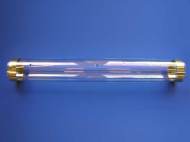A transparent film that prevents glass fogging developed
 While some researchers are developing hydrophobic surfaces and coatings in order to prevent foggy or frozen windows, researchers at the Fraunhofer Institute for Surface Engineering and Thin Films (Fraunhofer IST) in Braunschweig decided to take on a different approach. They developed a transparent and heatable film which ensures there’s no condensation or ice on windows.
While some researchers are developing hydrophobic surfaces and coatings in order to prevent foggy or frozen windows, researchers at the Fraunhofer Institute for Surface Engineering and Thin Films (Fraunhofer IST) in Braunschweig decided to take on a different approach. They developed a transparent and heatable film which ensures there’s no condensation or ice on windows.
If you own a car and live in a region with cold winters, fogged or frozen windows are the bane of your life in that period. Aside poor visibility if the windows mist up, you also have to go through the laborious morning ritual of having to scrape off the ice from your windows. Likewise, the winter poses its own problems for anyone with a greenhouse. The more condensation you have inside, the greater the threat to plants if the temperature falls below freezing.
While heaters may be a solution in many cases, a better option and more cost effective solution would be to ensure the problem does not arise in the first place. Researchers at the Fraunhofer IST came up with their solution by developing a process that can be used to manufacture transparent, conductive – and therefore heatable – films that prevent condensation on windows.
The window remains dry and ice-free. Films that up to now have been produced with tin oxide are both mechanically and optically still far from ideal. Cracks may form as a result of excessive temperature loads – a problem encountered during the glass bending process. As a result, tin-oxide films only have limited industrial applications.
„Our new film is extremely resilient”, said Dr. Bernd Szyszka from the Fraunhofer IST. „Temperatures up to 900 degrees Celsius are no problem, and even if you bend it aggressively – the film remains intact.”
The coating can therefore also be used in large industrial plants where transparent protective heaters are often required to monitor the process chain safely. The low emitting properties of the outer film ensure the window cools down much more slowly, preventing condensation.
Aside being easy to heat, without the need for wires commonly found in a rear-heated window, the film developed by Fraunhofer IST researchers boasts an optical transmission ratio of over 80 percent. The coating is also corrosion- and scratch-resistant, and it can be used to provide scratch protection for float glass –a sheet of glass made by floating molten glass on a bed of molten metal.









Leave your response!